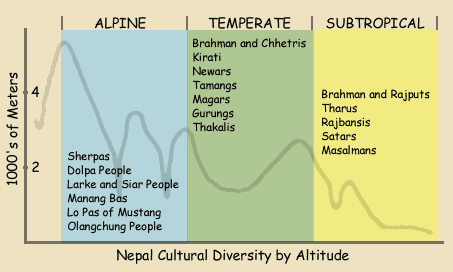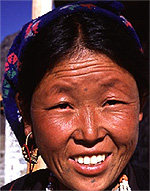Nepal's
People and Ethnic Groups

 Nepal
has a population of more than 26 million people, made up of over
40 different races and tribes. The country offers such diversity
that the visitor may experience any lifestyle from the stone age,
in far west and high hills, to the jet age of Kathmandu. Nepal
has a population of more than 26 million people, made up of over
40 different races and tribes. The country offers such diversity
that the visitor may experience any lifestyle from the stone age,
in far west and high hills, to the jet age of Kathmandu.
When you're ready to come and visit, contact our
Sponsors, Kathmandu
Travels & Tours , to be guaranteed immersion in the
culture and heritage of Nepal.
nepal cultural groups by altitude
The two major groups in Nepalese society are Tibeto-Burmans, or
Mongoloids from the north, and Indo-Aryans from the south. Many
customs are inherited from both sides and have been developed by
the influences of the land, climate and available resources.
The largest groups can be divided on the basis
of geographical
locations by altitude.

Alpine
Based Cultural Groups
High Himalayas
sherpas
Sherpa,
in literal terms, means people of the east in the Tibetan language.
Originally from Tibet about 500 years ago they have a close affinity
with the Tibetan language, culture and religion. Sherpas
major occupations include agriculture, animal husbandry, trade and
have become famous for trekking and mountaineering. Today they are
know worldwide for their skill and hardiness. They follow Buddhism
as their major religion.
dolpa people
The settlement of these people is considered the highest of any
living ethnic group in the world. These people live beyond the mountains,
west of the Kali Gandaki river valley. These people practice Buddhist
customs.
larke and siar people
Larke is the northern most part of Nepal's Gorkha district while
Siar is the northern part of the Dhading district. These people
mainly speak the Tibetan and Gurung languages and have ethnic affinity
with Gurungs.
manang bas
The people of Manang are called Manang Bas. Their major occupations
include trade and business. They have their own language and scripts
and maintain their own local religious practice with 12 villages
called Bara Gaule-Baragaun. The famous pilgrimage spot on the Annanpurna
Circuit, Muktinath, lies in their area. Although Buddhism is part
religion, they follow Bon-Po which pre-dates the reign of Bhuddha.
lo pas of mustang
The settler of Lo are called Lopas. They carry on trade between
Nepal and Tibet in the Upper and Lower Mustang areas. Buddhism is
their major religion. They have their own local language and festivals
outside typical Buddists as well.
olangchung people
These people are the inhabitants of Olanchung Gola, the main trading
route along Eastern Nepal. Besides Buddhism, they have their own
customs and practices.
Thudam, Topke Gola and Lhomis are other ethnic
groups within Nepal's alpine region.
Temperate Zone
Based Cultural Groups
Middle Hills and Valleys
brahmin and chhetris
Two large groups distributed in scattered patterns all over the
country, which are considered the two highest castes in Nepal. They
have sharp Indo-Aryan features and an olive complexion. Brahmins
are believed to have migrated from India while Chhetris are from
the present day Khasa people from Khasi. These people follow Hinduism
as their main religion and socially they have many sects. They are
divided into two major streams, the Purba and Umai. The Kumain people
are of the origin of Kumo, Northern India, Uttar Pradesh. Their
social practices depend upon Hindu religious epics. They speak Nepali,
the national language of Nepal and use a script with basis in Sanskrit.
kirati
Kirati mainly consists of Rai and Limbu people. Literally Rai or
Limbu means headman. They are decendents of the Kirati's who first
formed the kingdom in the Kathmandu Valley. They now mainly live
in far eastern Nepal. Kirati people are well known for their courage
and bravery and are often recruited into armies abroad like the
more famous Gurkhas. The religious text of Limbu is the Mundhum.
newars
Newars are mainly settled in Kathmandu Valley and in major trading
centers throughout the kingdom. They have Mongolian features and
their own language and script, Newari, believed to have its origin
from Tibeto-Burmans. Hinduism and Buddhism are their main religions.
They have complex social systems and practices and are comprised
of many castes. Trade and farming are their main occupations.
tamangs
In Tibetan language Tamang means horse traders. It is believed that
they originally came from Tibet. The majority of Tamangs live in
the hills surrounding Kathmandu Valley. Their social practices and
customs are based on Buddhism and they have their own language,
Tamang. They work mainly as farmers, labours and as porters.
magars
Their origin is basically found in hill regions of western Nepal.
Their religion is Buddhism
and their language, Magar Kura, depicts their affinity to the Tibeto-Burmese
tongue and culture. Farming, military service, weaving, hunting,
and fishing are their major occupations.
gurungs
They are famous for their innocence, simple mindedness, and bravery
while serving in military forces. They are mostly settled along
the higher slopes of the Annapurna areas and the Kali Gandaki river
above the Baglung district. They are farmers of rice and grains
and also sheep. They are ethnically related to Magars, Thakalis
and Kiratis in eastern Nepal. The Gurung people love music and they
have their own language.
thakalis
 The origin
of Thakali is Thok Khola, a high valley in central Nepal along the
Muktinath region. They have Mongolian features, a fair complexion
and narrow eyes. Thakalis are divided into four major groups: Gauchan,
Tulachan, Sherchan and Bhattacan. Their religion is a mixture of
Buddhism, Hinduism and Jhankrism. They are known for their hospitality,
good salesmanship, and cleanliness. The origin
of Thakali is Thok Khola, a high valley in central Nepal along the
Muktinath region. They have Mongolian features, a fair complexion
and narrow eyes. Thakalis are divided into four major groups: Gauchan,
Tulachan, Sherchan and Bhattacan. Their religion is a mixture of
Buddhism, Hinduism and Jhankrism. They are known for their hospitality,
good salesmanship, and cleanliness.
occupational castes
Certain ethnic groups in Nepal are categorised according
to their occupation. They are Kamis (smiths), Damais (tailors),
Dhibis (washerman) Sarkis (cobblers), Gaines (professional singers)
and Khumbharas (porters). The origin of these castes has not been
investigated yet by the anthropologists. Hinduism is their major
religion and Nepali their major language. Many have their own local
festivals and practices.
Furthermore, Sunwars, Jirels, Chepangs, Kusundas
and Panchgaule (five villages) are other minor ethnic groups of
the Nepal midland hill regoins. Sunwars are Jirels are considered
to be the off shoots of Magars. Panchgaule are similar to Thakalis.
Kusundas still live in primitive conditions. They live in caves,
under trees and in temporary huts in the forest. Only a handful
of them are settled into occupational farming. Chepangs, who are
believed to be the offshoots of Kirats, are slowly moving into urban
areas.
Subtropical
Based Cultural Groups
Ethnic Groups of Terai Region and Southern Nepal border.
brahman and rajputs
These a people are similar to Bramin and Chhetris of the middle
hills. Their major difference being a high degree of influence from
the neighbouring North Indian people.
tharus
This is the largest and oldest ethnic group of the Terai belt found
living in close proximity to densely forested regions. They are
dark in complexion and have smart, trim bodies. They follow the
Hindu religion and their practices are dependent on many typical
Aryan practices. Farming and business are their main occupations.
Danwars, Majhis and Darais are very similar to Tharus, physically
and culturally. Nevertheless, they speak their own languages which
are of Sanskrit origin.
rajbansis
This is a dominant ethnic group of far eastern Terai areas of Jhapa
and Morang. Although they follow both Hindu and Muslims religions,
they have their own local practices. Farming is their major occupation.
satars
They are similar to Santhals of Bihar, India. They are very much
like Tharus and their social life is organised and disiplined. They
believe in Hinduism. Dimals, Bodos, Dhangars are agriculturist Hindu.
Bodos are settled in an area know as the Mechi Zone and are more
known as Mechain people. Dhangars, who live in one part of the eastern
Terai have their origin in Madhya Pradesh, India. Dhimals are the
Terain counterparts of the Limbus from the eastern Terai, mainly
in Jhapa.
musalmans
There are Muslims migrated from Northern India. They speak Urdu
and their social practices correspond with the Muslim religion.
Although these above accounts depict a fundamental
description of Nepalese ethnic groups, it is difficult to pin point
who is "ethnic" and who is "non-ethnic", who
is "indigennous" and who is "non-indigenous"
in a particular place. Past migration histories mean Nepal seems
to be a melting pot. This is especially prevently in urban areas.
related
topics
 |
|
other
topics viewed by visitors
 |
|
|

 Nepal
has a population of more than 26 million people, made up of over
40 different races and tribes. The country offers such diversity
that the visitor may experience any lifestyle from the stone age,
in far west and high hills, to the jet age of Kathmandu.
Nepal
has a population of more than 26 million people, made up of over
40 different races and tribes. The country offers such diversity
that the visitor may experience any lifestyle from the stone age,
in far west and high hills, to the jet age of Kathmandu.
 The origin
of Thakali is Thok Khola, a high valley in central Nepal along the
Muktinath region. They have Mongolian features, a fair complexion
and narrow eyes. Thakalis are divided into four major groups: Gauchan,
Tulachan, Sherchan and Bhattacan. Their religion is a mixture of
Buddhism, Hinduism and Jhankrism. They are known for their hospitality,
good salesmanship, and cleanliness.
The origin
of Thakali is Thok Khola, a high valley in central Nepal along the
Muktinath region. They have Mongolian features, a fair complexion
and narrow eyes. Thakalis are divided into four major groups: Gauchan,
Tulachan, Sherchan and Bhattacan. Their religion is a mixture of
Buddhism, Hinduism and Jhankrism. They are known for their hospitality,
good salesmanship, and cleanliness.
